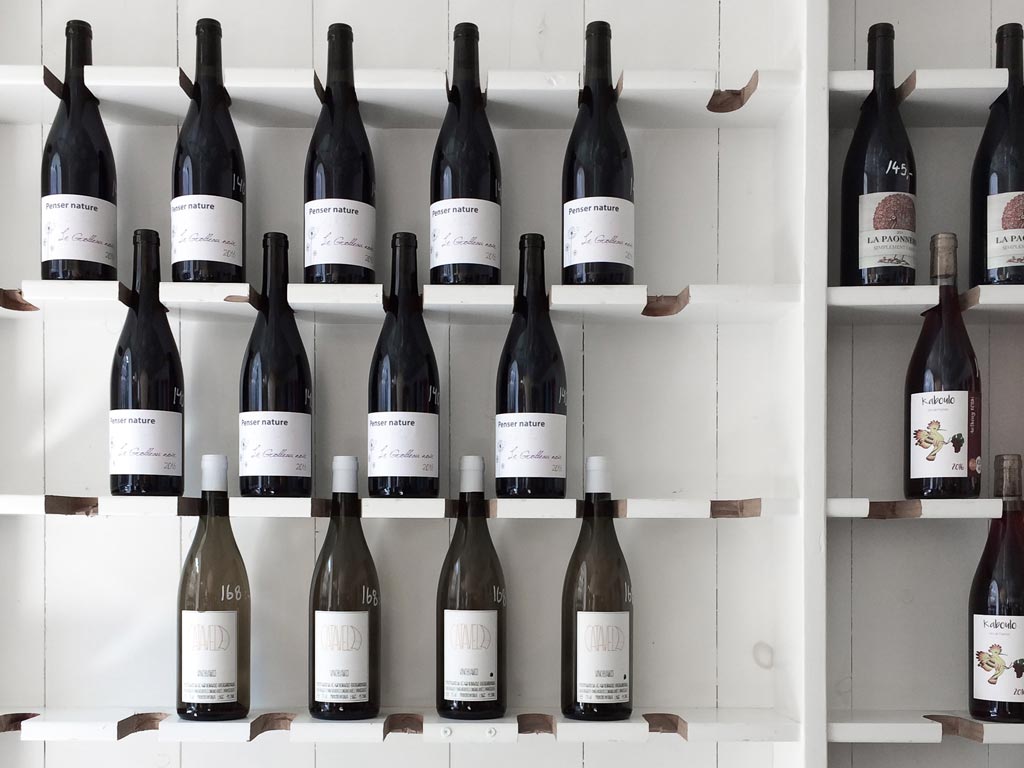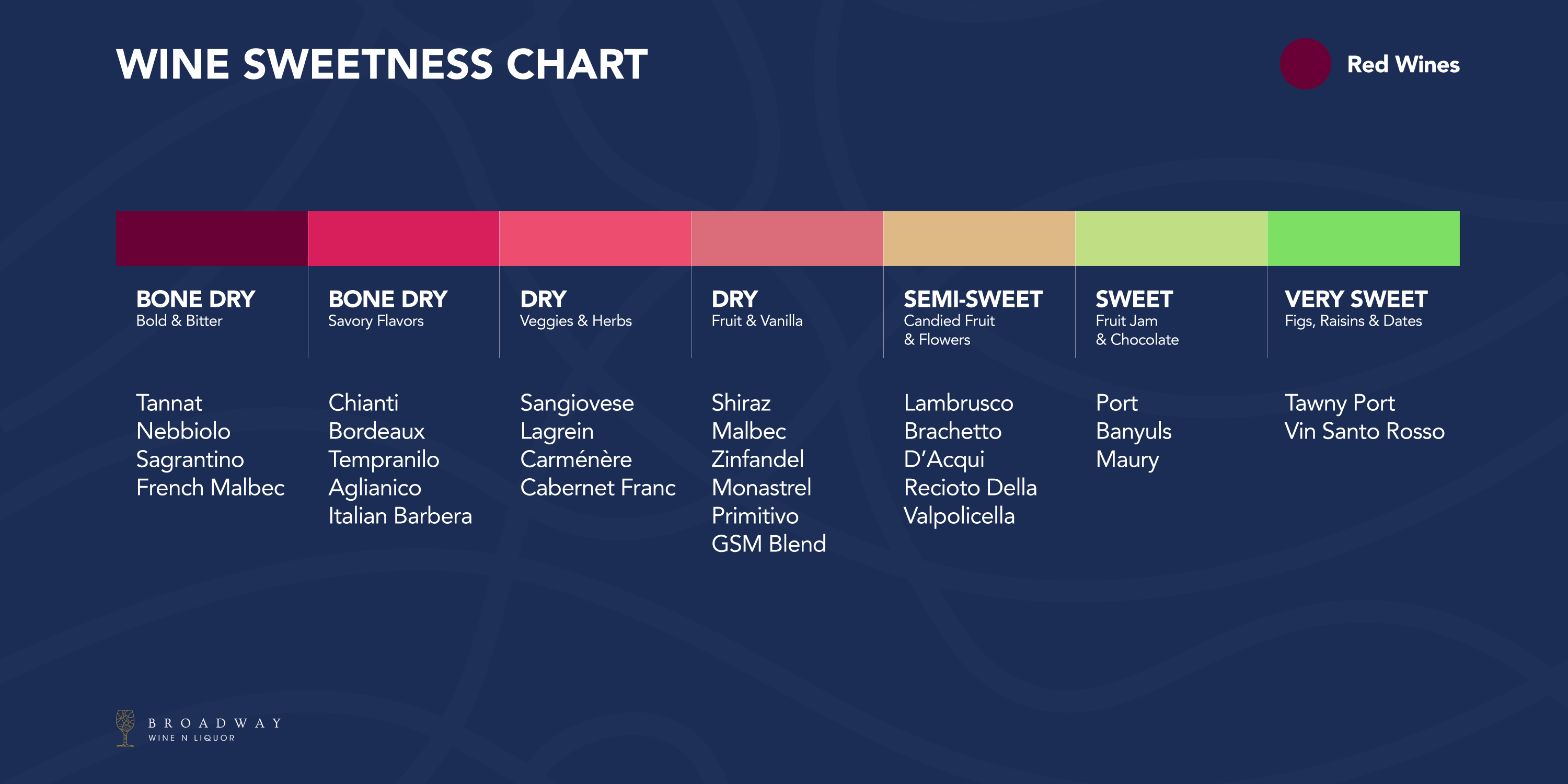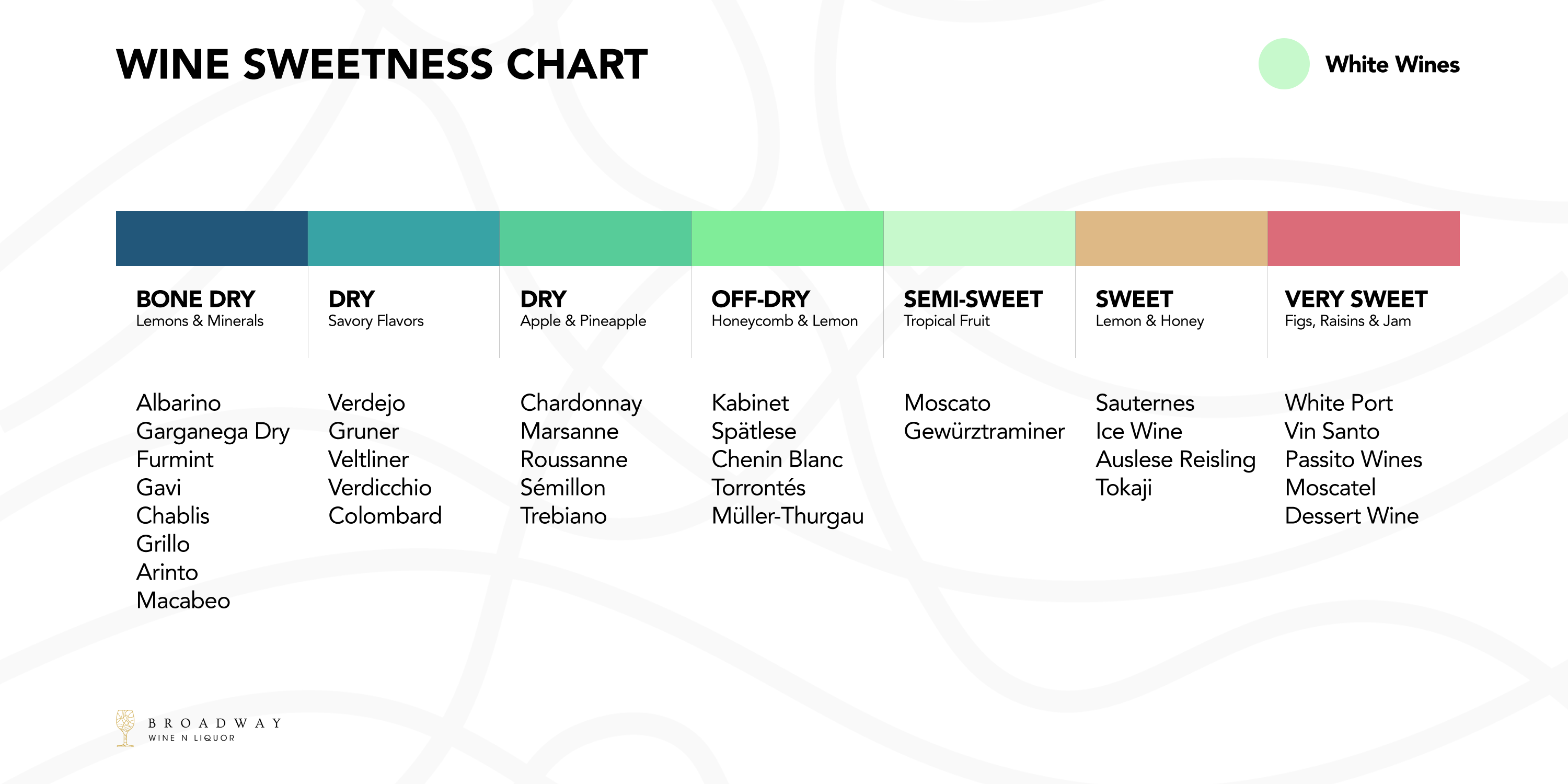
If you are new to wine, one of the first things you will want to know is about the sweetness. Sweetness is a major flavor factor, and it can be annoying to ask whether through so many wines whether they are sweet or dry. Do you think chardonnay is sweet? Is Pinot Grigio sweet? Most people are often surprised by these two popular white wines. Both happen to be dry (not sweet). However, you may still be surprised to know that you like the fruity flavours of these wines (even if they are not as sweet as you would like). With our wine sweetness chart for both red wines and white wines, it is easy to see which dry and sweet wines you might like. Read on to discover our wine sweetness chart and learn all about the different tastes of wine, from sweet and fruity Moscato to rich and creamy Chardonnay.
Red Wine & White Wine Sweetness Chart
“Bone Dry” is a technical term meaning there’s no more sugar in the wine. Styles that normally land in this category include Bordeaux, Pinot Grigio, Tempranillo and Albariño. Dry wines generally refer to examples with less than 10 grams of sugar per liter (g/l), often including Cabernet Sauvignon and Cabernet Fran, Sauvignon Blanc, Vignier, Syrah, Zinfandel, Garnacha and Chardonnay.
“Dry” wines generally range between 10 and 20 g/l. Examples are Riesling, Chenin Blanc and Champagne.
The term “sweet wine” can be applied to any off-dry wine and above, but is generally reserved for wines of 20 g/l or more. Any wine between 20 and 75 g/l is usually called semi-sweet wine, like Lambrusco or Moscat. The types of “very sweet” wine, such as Tawny Port and Vin Santo Rossi wine, are usually 75 g/l or more.
Regardless of where a particular style fits on the wine’s sweet map, it is good to remember that residual sugar content and perception of sweetness are two different factors that are both related to the sweet taste of something. While residual sugar refers to the actual sugar level of the beverage, the perception of sweetness is more complex and can also occur in dry wines. For example, when a wine has tastes or aromas associated with sweetness (floral or fruity notes, I think), our taste is more often read as sweet. Other characteristics of wine, such as high levels of alcohol, can also increase the perception of sweetness, while factors such as acidity and tannins can reduce it.

Why do some wines taste sweeter than others?
As we see above in our wine sweetness chart, some wines are so dry that they scrape the moisture from the tongue and make the inside of the mouth stick to the teeth. At the other end of the spectrum, some wines are so sweet that they stick to their glasses like motor oil. Writers who have been writing about wine for years have inserted words into the concept of dryness, and food scientists have in fact studied why some wines taste drier than others. Both groups claim that taste, tannin and acidity are fundamental components of why wine tastes “dry”.
What is interesting about tannin is that a recent study showed that some people are more sensitive to tannin based on the amount of protein naturally present in their saliva. People with more protein in their saliva do not feel the effect of tannin drying as much as people with less protein. Another interesting fact is that the taste of tannins decreases in combination with salty and fatty foods.
Like what you are reading? Try these related stories...
How to spot a sweet white wine
Have you ever tasted a certain style of wine just to understand that the wine you bought does not have the same taste you expected? Maybe you have a dinner planned that goes perfectly with the sweet Riesling, or you just want a crispy Sauvignon Blanc. You are in the wine department and have no idea how to tell if the wine will be sweet or dry, because all the labels are confusing the AF. Don’t be afraid. Here are some tips and tricks to understand how sweet the wine will be before you buy it:
Check the ABV and RS
Sweetness is measured by calculating the residual sugar (RS) left in the wine after fermentation. If all the sugar in the wine has been transformed into alcohol, then the alcohol by volume (ABV) tends to be high and the RS will be low (or 0). This wine will be at the driest end of the spectrum. On the other hand, if after fermentation the wine still has some sugar, then the ABV tends to be lower and the SR is higher, resulting in a sweeter wine. If you want a sweet wine, look for bottles with 11% GLA or lower, and for dry wines usually 14% or more. This is a good rule of thumb, but like any wine, there are exceptions.
Check out the common styles of sweet wine
Dry white: Chardonnay, Sauvignon Blanc, Pinot Gris,
Dry red: Pinot Noir, Sira, Malbec, Merlot, Zinfandel, Cabernet Sauvignon, Cabernet Fran.
Slightly sweet: Riesling, Chenin Blanc, Gewurztraminer, Moscato.
Strongly sweet: dessert wines – sherry, port, sauterne, cold wine.
Wine Sweetness Chart Indicators
Wines can be freely divided into sweet, semi-dry or dry. Normally, the amount of residual sugar of a wine depends on its level of sweetness. Remember that during fermentation, the natural sugar contained in the grapes is converted into alcohol by yeast. When fermentation stops before all the sugars are converted, the alcohol content is reduced and the wine becomes sweeter.
In table wines, the lower the alcohol content, the higher the residual sugar content and the sweeter the wine. There are exceptions to this rule, but it is a good general rule. This is one of the reasons why German Riesling is often found with an alcohol content between 8 and 12% GVA, with a significantly higher residual sugar content.
Categories of sweet red wine
The most famous sweet red wines fall into the category of dessert wines. You will want to visit this section while shopping. You can look for wine labels that fall into several categories:
German Dornfelder grapes are often produced in a lighter and slightly sweeter version. Although it is not too exported, it is definitely in the US markets. It is worth a try if you are looking for a sweeter red wine style. Italian Lambrusco is a slightly sweet, slightly sparkling and inexpensive red wine that has fascinated wine lovers around the world for many years. It is intended for young consumption and is easily available in most markets. In Australia, sweet red wines should be called ‘sticky’. They can use a wide range of grapes, and many producers have incorporated them into their success stories. Fortified wines, known as Porto, also live up to the expectations of sweet wines.
What wines are sweet?
Sweet wines are categorized based on their level of residual sugar, which refers to the amount of sugar left in the wine after fermentation is complete. Popular wines that are sweet include Dessert Wines, Fortified Wines, Port, Sherry, Sweet Riesling, Muscat, Moscato, Lambrusco and Moscato d’Asti wines.
Remember that sweetness levels can vary even within the same type of wine, so it’s essential to check the label or ask for assistance when selecting a sweet wine that suits your preferences.
FAQ
Is Pinot Grigio sweet?
No, Pinot Grigio is generally not considered a sweet wine. It is typically known for being a dry white wine with crisp acidity and subtle fruit flavors. Dry wines have minimal residual sugar, meaning that most of the grape’s natural sugars are fermented into alcohol during the winemaking process, resulting in a lack of sweetness.
What is the sweetest wine?
The sweetest wines are typically classified as “dessert wines” or “sweet fortified wines.” These wines are made from grapes with high sugar content, and the fermentation process is stopped before all the sugar is converted into alcohol, resulting in a higher level of residual sugar.
Is Cabernet Sauvignon dry?
Yes, Cabernet Sauvignon (often abbreviated as “Cab Sav”) is generally considered a dry red wine. “Dry” in wine terminology means that the wine contains very little residual sugar, as most of the grape’s natural sugars have been converted into alcohol during the fermentation process. Cabernet Sauvignon is one of the most popular and widely recognized red grape varieties globally. It produces full-bodied wines with rich flavors of dark fruits, such as blackcurrant, blackberry, and plum, along with notes of tobacco, cedar, and sometimes mint. These wines are known for their firm tannins and good aging potential.
What are some sweet wine names?
Sure! Here are some sweet wine names from various regions around the world:
Sauternes: A French sweet wine from the Bordeaux region, made from botrytis-affected grapes (noble rot), resulting in a lusciously sweet and complex wine.
Tokaji Aszú: A Hungarian dessert wine made from grapes affected by noble rot, producing a rich and sweet wine with flavors of honey, apricot, and marmalade.
Ice Wine/Eiswein: Made from grapes that have frozen on the vine, producing intensely sweet and concentrated flavors.
Late Harvest Wines: Wines made from grapes left on the vine longer than usual, allowing them to become overripe and develop higher sugar levels.
Muscat/Moscato Wines: Wines made from Muscat grapes can be sweet, ranging from slightly sweet to intensely sweet, with pronounced floral and fruity aromas.
Vin Santo: An Italian dessert wine made by drying grapes before fermentation, resulting in a sweet and nutty wine.
Pedro Ximénez (PX): A type of Sherry wine from Spain made from sun-dried Pedro Ximénez grapes, producing a very sweet and dark wine with notes of raisins and figs.
Banyuls: A French sweet wine from the Roussillon region, made from Grenache grapes and aged in a solera system, resulting in a fortified, sweet wine.
Lambrusco Dolce: A sweet version of the Italian sparkling red wine Lambrusco.
Recioto della Valpolicella: An Italian wine from the Veneto region made from partially dried grapes, producing a sweet and rich red wine.








